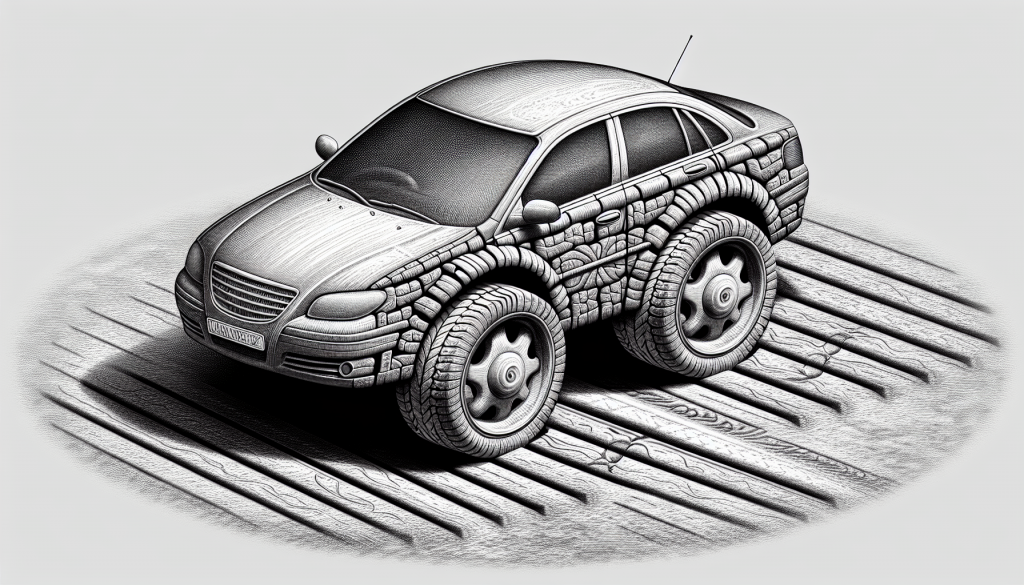Spotting Wheel Alignment Problems
Signs Your Wheels Are Out of Whack
Keeping your wheels aligned is key to a smooth ride and safe driving. Here’s how to tell if your wheels need some TLC:
- Uneven Tire Wear: If one side of your tire looks more worn out than the other, it’s a red flag.
- Pulling to One Side: If your car drifts to one side on a straight road, your alignment might be off.
- Off-Center Steering Wheel: Your steering wheel should be straight when you’re driving straight. If it’s not, you’ve got an alignment issue.
- Steering Wheel Vibration: Feeling a shake in your steering wheel, especially at high speeds? That’s a sign your wheels aren’t aligned.
- Squealing Tires: Hearing a squeal when you turn? Your tires might be crying out for an alignment.
Why Regular Wheel Alignment Checks Matter
Getting your wheels checked regularly isn’t just about avoiding annoying problems—it’s about saving money and staying safe:
- Longer Tire Life: Proper alignment means your tires wear evenly, so they last longer.
- Better Gas Mileage: Misaligned wheels make your car work harder, burning more fuel.
- Safer Handling: Good alignment helps your car handle better, especially in tight spots or sudden turns.
- Save Money: Regular checks can catch problems early, avoiding expensive repairs down the road.
Want more tips on keeping your suspension in top shape? Check out our suspension system maintenance page.
How Misalignment Messes with Your Ride
Misaligned wheels can mess up your car’s performance big time. Here’s how:
| Problem | What It Means |
|---|---|
| Worse Gas Mileage | Misalignment makes your car work harder, using more fuel. |
| Bad Handling | Your car won’t handle as well, making it tricky to control, especially in turns. |
| Faster Tire Wear | Uneven wear means you’ll need new tires sooner. |
| Suspension Damage | Misalignment can strain your suspension, leading to costly repairs. |
If you’re dealing with alignment issues, don’t wait. Find a pro to help you out. Check our guide on suspension alignment near me for trusted service providers.
Keeping your wheels aligned is crucial for a smooth, safe ride. Regular checks and timely fixes can save you money and keep your car running longer. For more advice on handling alignment problems, visit our article on solutions for suspension issues.
Fixing Your Wheel Alignment Woes
Keep an Eye on It
Regular check-ups are key to keeping your wheels in line. Stick to a schedule and catch problems early. This way, you avoid bigger issues down the road and keep your ride smooth. Aim for a check every 6,000 to 10,000 miles or at least once a year.
| Check-Up Frequency | Mileage Interval |
|---|---|
| Regular Check | 6,000 – 10,000 miles |
| Annual Check | Once a year |
Precision Tools Matter
Using top-notch tools is a must for spot-on wheel alignment. High-tech gadgets measure wheel angles with pinpoint accuracy, making sure adjustments are just right. This cuts down on mistakes and boosts the whole alignment process. Curious about these tools? Check out suspension alignment tools.
Get Those Angles Right
Nailing the camber, caster, and toe angles is crucial. These angles decide how your tires touch the road.
- Camber: Tilt of the wheels when you look at them from the front.
- Caster: Tilt of the steering axis when you look from the side.
- Toe: Tilt of the wheels when you look from above.
| Alignment Angle | What It Means |
|---|---|
| Camber | Vertical tilt of the wheels |
| Caster | Forward or backward tilt of the steering axis |
| Toe | Inward or outward tilt of the wheels |
Want to dive deeper? Check out our guides on adjusting camber, adjusting caster, and adjusting toe.
Hit the Road After Alignment
After tweaking your alignment, a road test is a must. Drive around to see if everything feels right. If something’s off, you can fix it right away.
New Tires? Check Alignment
Got new tires? Make sure to check the alignment. This keeps your tires wearing evenly and your car handling well. Skip this step, and you might wear out those new tires faster. For more info, visit alignment check for new tires.
Train Your Techs
Keeping your technicians up-to-date with the latest gear and techniques is super important. Well-trained techs mean better alignment service. For training resources, see suspension alignment training.
Teach Your Customers
Helping customers understand why alignment matters can make a big difference. When they know the benefits, they’re more likely to keep up with regular checks. For more educational resources, visit suspension alignment benefits.
Adjust for the Seasons
Road conditions change with the seasons, and so should your alignment. Seasonal tweaks keep your car performing its best all year round. For more info, see seasonal suspension alignment adjustments.
Watch Your Tires
Uneven tire wear is a big red flag for alignment issues. Keep an eye on your tires and catch problems early. This helps maintain alignment and extends tire life. For tips, visit monitoring tire wear patterns.
Fix Suspension Problems
Your suspension needs to be in good shape for proper alignment. Fix any suspension issues to make sure your alignment is spot-on. For more details, see correcting suspension issues.
By following these tips, you can tackle wheel alignment problems head-on and keep your vehicle running smoothly. Proper alignment not only makes driving easier but also helps your tires and suspension last longer.



